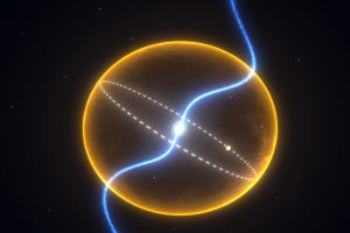An international research team has discovered a small diamond planet in the Milky Way that was once a massive star.
 The newly-discovered pulsar
The newly-discovered pulsar
The team has been led by Swinburne University of Technology’s Professor Matthew Bailes. Researchers from the University of Manchester and other institutions in the US, Italy, Germany and Australia have first spotted a pulsar, an unusual star, using the Parkes radio telescope and Lovell radio telescope.
Pulsar is referred to as a small spinning star with approximately 20 km in diameter and it emits a beam of radio pulses. The radio telescopes noticed a regular pattern of radio waves, as the star spins and the radio beam gets radiated continuously over the Earth.
PSR J1719-1438 is the newly detected pulsar and it is an ultra fast-spinning pulsar. The pulsar spins over 10,000 times per minute. It is 20 km in diameter and has a mass of approximately 1.4 times that of the Sun. By using special codes on supercomputers, researchers have detected the pulsar among 200,000 Gigabytes of data. Astronomers have detected that the arrival times of the radio pulses were methodically modulated. The gravitational pull of a small companion planet is the cause for such modulations. The modulations reveal several facts about the planet to astronomers.
The first one is that the planet made of diamond orbits the pulsar in 2 hrs and 10 min. The distance between the planet and the pulsar is 600,000 km. The next information is that the companion planet needs to be small with a diameter less than 60,000 km. Though the diamond planet is small in size, it has a slightly higher mass than Jupiter.